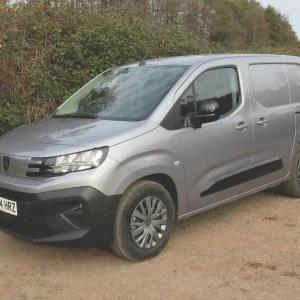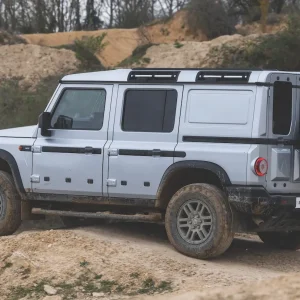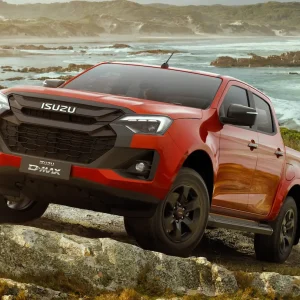Derived from its passenger car stablemate, the latest version of the three-door Corsavan is now offered with an Ecoflex badge. It denotes the fuel-frugal 1.3-litre 75hp CDTi diesel, with a CO2 figure of just 112g/km.
To have even less impact on the environment – and even lower fuel bills – you can specify it with a start/stop system. Still a rarity on light commercials, but becoming increasingly popular, it is the first time the system has been installed in a Vauxhall van, and costs £220.
Fitted to the Ecoflex van we tested, it kills the engine when idling in neutral at the lights or in a traffic jam, and prevents wasting fuel and polluting the atmosphere. Dip the clutch pedal and the engine starts again immediately. Net result? The van can boast an ultra-low CO2 figure of 105g/km. But what is more, it returns a remarkable 70.6mpg on the official combined fuel economy cycle. With that sort of economy on tap it is hard to fathom why anybody would want their Corsavan powered in any other way given the ruinously high price of diesel. The smallest model in Vauxhall’s light commercial range is, however, also on offer with a 95hp version of the 1.3 CDTi in Sportive trim – more performance and fancier specifications are always appealing – or a 70hp 1.2-litre petrol lump. Neither is available with stop/start alas, nor do they qualify for an Ecoflex label, but like all Corsavans they comply with the latest Euro5 exhaust emission regulations.
It’s worth bearing in mind that a facelifted Corsavan is due this spring, with the revised nose coming across from the imminent hatchback version, though not soon enough for this test.
Cab
For a small van, the Corsavan has a surprisingly roomy cab, with more legroom than one might expect.
Storage space for all the paraphernalia drivers have to carry around with them is, alas, at a premium, despite the presence of a tray under the passenger seat. The glove box is a lot smaller inside than the size of its lid implies, and both the bins in each door are narrow and shallow, although the lower one has a moulding designed to grasp a cup. There are two more cup-holders at the bottom of the attractively styled dashboard – the controls are a model of clarity – plus a 12V power point.
The driver’s seat is height- adjustable and so is the steering column; the latter is also adjustable for reach, but you have to pay extra for these features.
Load area
A half-height steel bulkhead divides the 0.92cu/m cargo bay from the cab. You’re alerted to its presence every time you release your seat belt because the metal tongue on the belt’s end bangs against it with a nerve-jarring clang as the webbing retracts.
While the Corsavan does not offer a vast amount of carrying space, there is sufficient to accommodate a couple of big tool boxes, or a sheaf of documents that needs to be delivered urgently, or a security guard’s dog. Four load tie-down points are provided although one suspects that their use will be infrequent.
The cargo bay is well-protected to half its height from minor scratches and scrapes, and virtually everything is covered in panelling apart from the blanks that replace the rear side windows. Our test van’s load bed was covered by a rubber mat for an extra £80.
Access is by means of a rear hatch complete with a heated window and a wash/wipe system, and there is a fairly deep lip over which goods have to be lifted. You will have to heave the spare wheel over that lip if you have a puncture because it is stowed in a well beneath the cargo floor. While that protects it from road dirt and makes it less likely that it will be stolen, it also means that you will have to unload whatever you are carrying before it can be extracted.
Powertrain
Employing a particulate filter, the Corsavan Ecoflex’s four-cylinder 16-valve turbocharged common-rail diesel comes complete with an intercooler and is married to a five-speed manual gearbox. The 95hp 1.3CDTi comes with a six-speed gearbox. Stop/start users may worry that they will end up flattening the van’s battery or wearing out the starter motor prematurely, but any concerns are groundless, says Vauxhall.
An enhanced starter motor is fitted, a high-performance battery has been installed and an electronic power management system
keeps tabs on everything that is happening. Neither the brakes nor the power steering are affected after stop/start switches off the engine – the rev counter needle points to ‘auto stop’ when it does so – and the ventilation system continues to work, while an extra water pump keeps the cab warm in cold weather.
Chassis and steering
Independent suspension with MacPherson struts is fitted at the front along with an anti-roll bar while progressive-rate minibloc coil springs help support the rear. Gas-filled shock absorbers are installed all round.
Our Corsavan sat on 14-inch steel wheels with plastic trims that were shod with Continental EcoContact 3 185/70 R14 tyres.
Electric power-assisted variable-rate rack-and-pinion steering is standard, offering a 10.1m kerb-to-kerb turning circle.
Performance
While the Corsavan’s diesel might be small on paper, it is surprisingly big on performance. Lively and flexible, it allows the little load lugger to hold its own around town and means that it won’t disgrace itself on high-speed dual-carriageway dashes either.
A precise gear change enables you to make the most of what the engine has to offer.
The sharp handling shows that electric power steering – once a by-word for zero feedback – has now come of age, but a lumpy, bumpy ride lets the van down. Noise levels are well-suppressed overall, but the diesel is a touch too noisy at idle.
Stop/start eliminates pointless idling, however. Although a little disconcerting initially, you soon get used to it, and it should mean that you will be filling up rather less frequently than you might have done in the past. It can be switched off if needs be – punch the ECO button on the fascia – but we suspect the majority of owners will want to keep it on most of the time. After all, why specify it if you are not going to make use of it?
We averaged 60mpg – not as good as the official figure, agreed, but still a respectable showing given that our test was conducted in some grim winter weather, with warnings about ice and slippery roads popping up constantly on the main dash display.
Equipment and dealers
With air-conditioning, rear parking sensors, Bluetooth and front fog lights, not to mention an infotainment package incorporating satellite navigation, a radio/single-CD player with remote controls on the steering column and MP3 compatibility, our demonstrator was not short of goodies. It was in Club trim though, so all the foregoing were extra-cost options. You pay extra for electric windows too, which seems a little mean in this day and age, but electrically adjustable exterior mirrors come as standard.
The Corsavan is handled by 277 dealers so there’s no shortage of network support. Service intervals are set at 20,000 miles/12
months and Vauxhall’s smallest light commercial is protected by a three-year/60,000-mile warranty, with no mileage limit in the first year.
Emergency assistance is provided for the first 12 months after initial registration and a six-year body panel anti-perforation warranty is included in the deal.
Our demonstrator was not equipped with side rubbing strips and there was no protection for the wheel arches either. As a consequence its bodywork may pick up more than its fair share of minor dings.
Safety
The Corsavan might not be the biggest light commercial vehicle on the road but it has got to be one of the safest if the alphabet-soup of safety-related acronyms that come as part of the package is anything to go by.
Taking things from the top, it features ABS, EBA (emergency brake assist), EBD (electronic brakeforce distribution, CBC (cornering brake control), DTC (drag torque control, which helps maintain stability if you suddenly lift off the accelerator), and SLSC (straight line stability control). In addition there is DSAS (dynamic safety suspension) that is designed to help you keep control if you brake on surfaces with different levels of grip, such as gravel and dry tarmac. ESP is an option.
Ventilated disc brakes are fitted at the front while drums provide the stopping power at the back. Brake diameters are 257mm and 228mm respectively and the brake lights flash when the driver has to slam on the anchors so hard that the ABS is activated.
A driver’s airbag comes as standard with a passenger airbag listed as an option. The switch for the hazard warning lights is prominently positioned in the middle of the fascia. Hitting a button on the dashboard locks all the doors. Remote central locking is a feature too.
Summary
With dependable handling and a surprisingly roomy cab, Vauxhall’s Corsavan is a stylish and well thought-out package.
The 75hp 1.3-litre diesel engine offers ample performance, a precise gear change allows you to make the most of it, and in Ecoflex guise the little van promises to be frugal. Include stop/start in the deal and visits to the pumps will become even rarer. Vauxhall should be congratulated on offering such a system in one of its light commercials.
But the Corsavan cannot quite beat Ford’s Econetic Fiesta Van so far as CO2 is concerned, and its ride is a little lumpy. The cab also lacks storage space, although that is a drawback it shares with other light commercials of its size.
History – birth of a super Nova
Vauxhall’s parent GM is no stranger to marketing CVs in the UK: it used to sell them under the Bedford brand and Corsavan’s predecessors include the Bedford Chevanne, derived from the Chevette car.
The Corsavan’s own roots stretch back to the early 1980s, when the Corsa car, on which it is based, was launched. Replacing both the Chevette and Opel’s Kadett – Opel is Vauxhall’s sister brand – it was sold as the Nova by Vauxhall in the UK. The Novavan, however, did not appear until 1990. The Nova badge was dropped when the Mk II version arrived in 1993, with Vauxhall switching to the Corsa badge instead.
What Van? liked the van version of the mid-’90s Corsa, describing it in our July 1996 issue as “a top act and the best in its class”.
Employing the same platform as Fiat’s Grande Punto, the current Mk IV Corsa was launched in 2006, six years after the Mk III, and its Corsavan offshoot – a What Van? award winner in past years – has garnered a useful following. It is about to receive a cosmetic facelift in line with its car stablemate; there are no mechanical changes.
Verdict
We like the Vauxhall Corsavan Ecoflex a lot – but it remains number two to the Ford Fiesta.





